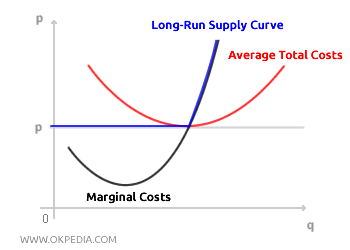Long-Run Supply Curve
The long-run supply curve corresponds to the line at the minimum average total cost and reflects the behavior of long-run marginal costs. In the long run, a firm’s optimal production level is determined by the intersection of the marginal cost curve and the average total cost curve. The long-run supply curve is illustrated below:

In contrast to the short run, firms in the long run must account for both variable costs and fixed costs when making decisions. During this period, firms have the flexibility to adjust factors such as facility utilization, production capacity, technology, and the number of plants (productive capacity). By comparison, in the short run, firms can only vary the usage of existing facilities, as changes to capacity or the number of facilities would require medium- to long-term investments.
Another significant difference between the short and long run lies in the number of firms in the market. In the short run, the number of firms is fixed, and any extra profits will only attract new entrants in the medium or long term. For a new firm to enter the market, it must plan investments, construct facilities, and more—processes that take time and cannot be completed in just a few months. In the long run, however, firms are free to enter and exit the market as needed (market entry freedom), ensuring that extra profits (no extra profit) are eliminated. If extra profits exist in a market, new competitors will quickly enter and compete until they are fully eroded. Ultimately, in the long run, extra profits disappear, and the market price aligns with the minimum average total cost.
